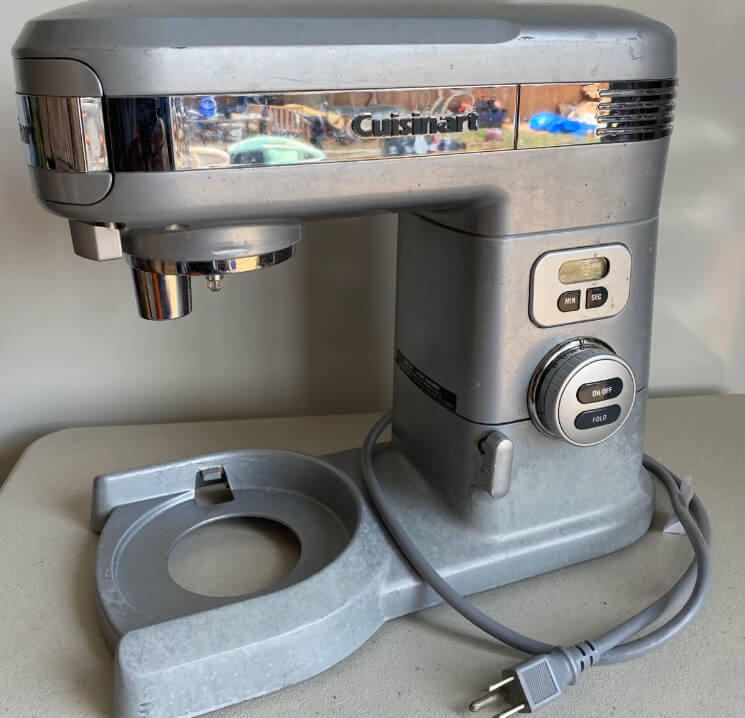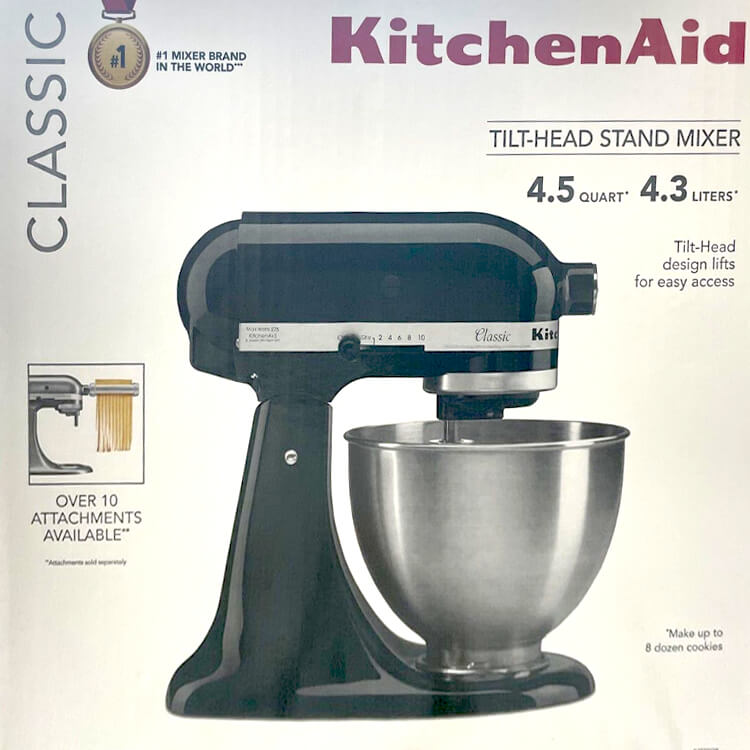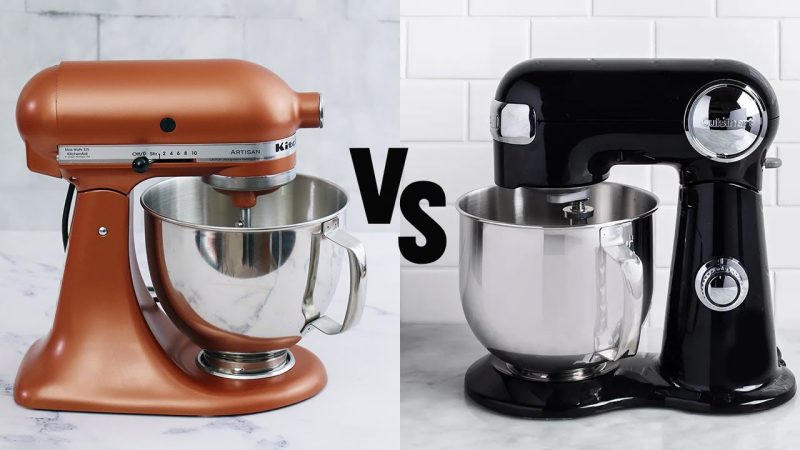Compare Stand Mixers from Kitchenaid vs. Cuisinart
Contents
After 400 hours of first-hand experience using and reviewing mixers, I feel I have some insight to share with our readers… But a little backstory first.
Twenty years, ago, I was a broke college journalism student. When I wasn’t working producing news shows at the local television station or going to school, I spent my time baking cookies and bread and cooking elaborate dinners for my friends. I could manage most of my culinary endeavors with my thrift store hand mixer, but so many recipes required the power and consistency of a stand mixer. My obsessive watching of the Food Network told me I could take my talents to the next level if I had a hands-free stand mixer. The popular choice was a Kitchenaid model. They appeared on my favorite cooking shows and populated store shelves in flashy colors. However, I’ve never been one to splurge on a large purchase without knowing what I was getting.
After much research, deliberation, and saving, I decided to invest my few hard-earned dollars in the 5.5 quart Cuisinart SM-55. Though I have used equivalent or even more expensive versions of the Kitchenaid stand mixer, I have never regretted my purchase. My mixer is now more than 10 years old. It gets used multiple times per week, much more often during the long Montana winters that I lovingly refer to as a baking season. Though it’s a bit dirtier than the day I bought it, it is still powerful, reliable, and my favorite countertop appliance.

There are many model options for both Kitchenaid and Cuisinart stand mixers. For the purposes of this review, I have chosen to focus on the Cuisinart SM-55, as it is the model with which I am most familiar and the Kitchenaid K45SSOB because that model has the most comparable price. Both models are available on Amazon for $199. (As of this posting, the Cuisinart mixer price has gone up to $218 for the black model.)

Value
For the money, Cuisinart is miles ahead of its Kitchenaid counterpoint when it comes to power, size, and versatility.
Both the Cuisinart and Kitchenaid are housed in durable die-cast steel. The Cuisinart comes in white or for a higher price can be had in black or stainless colors. The Kitchenaid comes in black, white or stainless at the $199 price point. For about $50 more, the Kitchenaid is available in a veritable rainbow of colors sporting fanciful names like ice blue, boysenberry, and empire red.
The Cuisinart has a larger bowl at 5.5 quarts versus Kitchenaid’s 4.5-quart bowl. The Cuisinart’s bowl is a beautiful and easy-to-clean brushed stainless steel. They both come with a whisk, flat paddle, and dough hook. However, the Cuisinart also comes with a splash guard. The Cuisinart provides a three-year product warranty and five-year warranty on the motor compared to Kitchenaid’s one-year product warranty. When it comes to power, the Cuisinart blows the competition out of the water with a 800-watt motor. The Kitchenaid sports a paltry 250 watts.
Though you can get the Kitchenaid in many fancy colors and there are many nifty add-on attachments available (some cost about as much as the mixer), I stand by the opinion that if you are looking for a powerful, long-lasting stand mixer, the Cuisinart is the best bang for your buck.
Functionality
Auto-shutoff timer – One of the things I love the most about the Cuisinart mixer is the 15-minute back-lit digital countdown auto-shutoff timer. This feature not only allows you to time your stirring and kneading but also prevents you from over-whipping or over-mixing by shutting off when the timer goes off with a clearly audible beep. It beeps every few minutes until you turn the timer off to remind you that you have a delicacy in the making in need of your attention. I cannot overstate the value of this feature enough. The Kitchenaid has no timer feature.
Maintenance
While the included attachments are similar in function, I really like the non-stick coating on the Cuisinart paddle mixer and dough hook. I have never had trouble getting even the stickiest, dried-on pizza dough off my attachments. This coating has not scratched or flaked at all in the 10 years I have owned my machine. The attachments are dishwasher-safe. Kitchenaid’s attachments have a nylon coating that make for easy cleaning. However ,they have a small groove and a spring where they fit onto the machine. These places tend to collect dough and other baking gunk making them difficult to clean.
Bowl Reach and Size
The Kitchenaid advertises an impressive-sounding 59-point “planetary mixing action.” However, in my experience, the Cuisinart’s reach is excellent and even superior to the Kitchenaid’s. I have had to do multiple scrape-ups in the Kitchenaide to get batter in the bottom that this planetary action just doesn’t reach. The Cuisinart bowl has a slight rise in the bottom that helps to avoid this missed spot. While it’s still important to scrape down your bowl from time to time, I think the Cuisinart whip and paddle mixer do better jobs at reaching all points of the bowl.
When it comes to the bowl size, 5.5 quarts is adequate for everyday baking, but is the smallest bowl I would recommend. I often put the bowl’s capacity to the test with a mere double batch. A 4.5 quart bowl simply is not big enough and would lead to spillage or the need to make batches one at a time.
Speeds
The Cuisinart has a full range of twelve speeds. They go from a gentle fold to an impressive hi-torch whip. The fold function is great for preventing over-mixing cookie dough, which every good cook knows can cause your cookies to be tough and flat. When you combine the highest speed with the wire whisk, you can produce whipped cream or meringue in minutes. The speeds in between are distinct and easy to achieve by turning a dial. The Kitchenaid’s 10 speeds leave the high end not high enough and the low end too fast for delicate work. Also, though it says 10 speeds, the way the machine is configured makes it feel more like five. There speeds are marked in increments by two and finding the in-between speeds can be tough.
Controls
When using other’s Kitchenaid mixers, I’m always perplexed and annoyed by the speed control. It feels clumsy and imprecise. I often accidentally switch to a much higher speed than I intended. Meanwhile, the Cuisinart has a smooth dial with the speeds marked. The transitions between speeds are far enough apart to avoid cranking it unless you meant to. There is also a slight delay when changing speeds and also when you initially begin mixing. This buys you precious seconds to turn the machine down and avoid powder sugar flinging to all corners of your kitchen if you accidentally start with the dial at 12.
Tilt Head
Both machines sport a tilt head. The higher-end Kitchen Aid mixers use a bowl lift. Like the controls, the Kitchenaid tilt head feels ungainly. The machine always seems top-heavy to me. I’ve feared knocking the whole thing backward when tilting the head up. The Cuisinart’s solid construction and even weight distribution prevent this sensation. The Cuisinart mixer also locks both in the up and down positions, while the Kitchenaid does not. I have experienced the kitchenaid clanging down when I’ve meant it to be in the up position.
Attachment Performance and Uses
Paddle Mixer
The paddle mixer is your go-to attachment for all general mixing and stirring. I use this attachment for cookies, cakes, muffins, breads, and more. It is contoured to reach the bottom and sides of the bowl and does an excellent job at incorporating all your ingredients.
Wire Whisk
The wire whisk is great for beating egg whites into fluffy meringue and whipping cream to a perfect consistency. I also occasionally use this attachment to gently stir dry ingredients together.
Dough Hook
When you combine the dough hook with the Cuisinart’s powerful motor, this stand mixer becomes a dough-making machine! In the ten yours I’ve had my mixer, I’ve put it to the test with double batches of yeast breads, triple and quadruple batches of pizza dough, and countless doughnuts and rolls.
Optional Attachments
The Cuisinart SM-55 sports three power outlets to give you the option of using a much wider variety of attachments than the Kitchenaid. The high speed power outlet on the top can run a blender and food processor. The mid-speed outlet powers a citrus juicer. The slow-speed power outlet on the front is for a large meat grinder and pasta maker attachment. It used to be harder to find the attachments for the Cuisinart and when you could, they were much more expensive. Now, these add-ons are easily found online and at very comparable prices to their Kitchenaid counterparts.
The Kitchenaid offers a meat grinder, pasta maker, ice cream maker and more.. All attachments run off the same 250 watt motor that powers the mixer, giving you less custom power variability.
Room For Improvement
While I will defend the superiority of the Cuisinart mixer to the Kitchenaid until the end of my days, I do acknowledge a few areas on my beloved mixer that leave room for improvement.
First, I do find it a bit clumsy to add ingredients. I fought with the included splash guard for the first couple of years before deciding to abandon it altogether. The spout was too small and poorly placed to add even a quarter cups of flour at a time. Even without the splash guard on, because of the large head of the machine, it is quite difficult to add ingredients with the head in the down position and very messy to do while it is running. I occasionally do it anyway and fight the mess later, but I mostly stop the mixer, tilt up the head, and add my ingredients that way. I cannot say that this problem is any better on the Kitchenaid variety of mixers.
Other Mixers
While Kitchenaid and Cuisinart are the focus of this article and two of the most popular choices, it is worth mentioning a few of the other comparable models on the market.
Bargain
Hamilton Beach 6-speed Classic Stand Mixer – $29.99
The Hamilton Beach rates as the best bargain stand mixer. It sports a four-quart stainless steel bowl, a 290-watt motor, and mixers, whisk, and dough hooks. Though these specs make it sound somewhat similar to more expensive mixers, this is where the similarity ends. The Hamilton Beach only has six speeds and uses traditional mixers and doesn’t have planetary mixing action. This will mean making it necessary to scrape the bowl down frequently.
Mid-Range
Oster Planetary Stand Mixer – Black – $149.99
The Oster has a 350-watt motor; 12-speed; a locking tilt head; a 4.5-quart bowl; and comes with a whisk, flat paddle and dough hook attachments. This machine only comes with black and does not offer a port for any other optional attachments. Customers review this mixer as a good bargain choice, however, it does not stand the test of time the way the Cuisinart or Kitchenaid do.
Professional
Kitchenaid 6 Quart Professional Series Bowl Lift Stand Mixer – $298.99
While this article made many comments about the 4.5 quart Kitchenaid stand mixer, this review would be remiss to not mention the professional Kitchenaid mixers. For a higher price, this series offers a much larger bowl at six quarts and a more powerful 575-watt motor. Instead of the slightly unstable tilt-head of the less expensive version, the Pro-series Kitchenaid comes with a lift bowl. This mechanism offers more stability when mixing heavy ingredients or large batches. The Pro-series also has a slightly different design to the dough hook meant to be used for kneading larger and tougher batches. This version advertises that it can handle as much as eight loaves of bread in a go. It comes in at least 10 flashy colors and fits with the same range of optional attachments as other Kitchenaids. However, it still has a few of the less desirable qualities such as the hard-to-clean groove in the mixing attachments and clumsy speed shift.
Conclusion
When it comes to countertop stand mixers, I will forever be a huge proponent of the Cuisinart SM-55 5.5 quart. The Kitchenaid, with its flashy colors and variety of attachments, can be found collecting dust or even mixing up cookies and cakes in kitchens all across America, but when it comes to power, user-friendliness, and longevity, nothing beats the Cuisinart.


I love my Cuisinart SM70. I’ve been using it for lots of bread baking for probably 10 yrs. I wish there was a way to clean the inside, maybe oil the motor and replace the filters. I can’t find directions for that kind of maintenance. Anyone have any ideas?
I enjoyed your article very much and I’m so glad to here some one defend the Cuisinart stand mixer I have been a home baker for 15 plus years. I just had to retire my second Cuisinart 7.5 (sm-75) model. Unfortunately they have quit making this model and I’m very sad. I to loved the timer on the Cuisinart, but I tell my husband all the time that I wish the person that designed the splash guard had to use it before they sold it. I believe they worked definitely redesign it. Nothing against kitchenaid products I just believe people purchase them for the name. I too like you do research before purchases. That’s why I sent back with Cuisinart again. I may have to settle with the sm55 now and refigure my recipes.
Thanks
Rhonda Edge